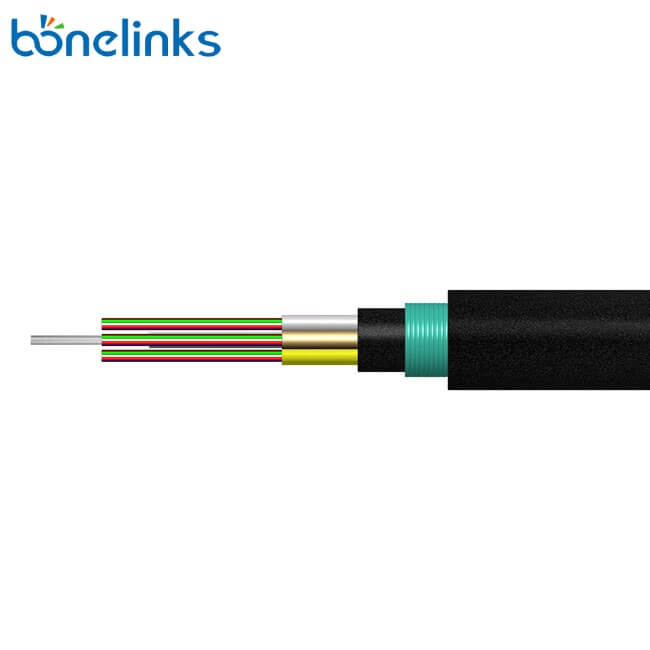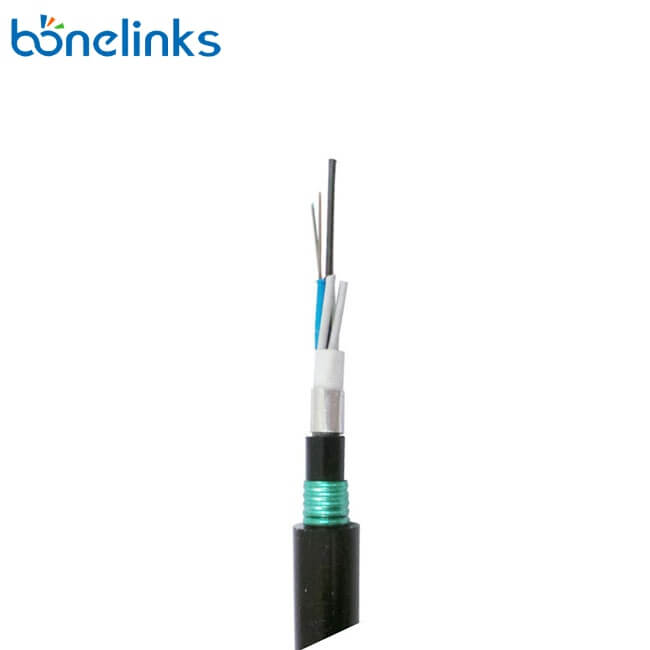Rodents often damage fiber optic cables. This damage can affect the long-term reliability of outdoor fiber optic cables, depending on the specific species of rodents (rats, birds, squirrels) and geographic location (mountains, hills). However, anti-rodent fiber optic cable has high tensile and compressive strength to prevent rodents and other animals from biting.
1.What is Anti-rodent Fiber Optic Cable?
Due to factors such as ecological protection and economy, it is not appropriate to take measures such as poisoning and killing rodents in optical cable lines, nor should it be prevented by burying them as deep as direct buried fiber optic cables. Therefore, the current anti-rodent measures for optical cables still need to rely on the structural design and material changes of optical cables for prevention.
Anti-rodent fiber optic cable is suitable for places where rats are prone to occur. Optical cables are made of special materials and have special structures. Its special material prevents communication interruptions due to damage to the optical fibers in the cable. At present, there are two main methods of physical rodent protection: metal armored protection and non-metal armored protection. Depending on the installation environment, the structure of the anti-rodent optical cable will also be different. For example, if the optical cable is laid in a pipe, steel belts and nylon sheaths are usually used to prevent rodents. If the optical cable is laid overhead, glass yarn or FRP armor is usually used. And the structure is mostly non-metallic.
2. Anti-rodent Method of Fiber Optical Cable
2.1 Metal Armored Protection
The steel belt sheath rodent proof mainly utilizes the hardness of the steel belt. Based on this principle, various manufacturers have introduced steel belt sheath rodent-proof optical cables. High-strength steel strips have a good anti-rat effect, but they also have shortcomings.
- After the outer sheath is bitten by a rat, the steel strip exposed to the external environment will aggravate the corrosion, and most optical cables will be corroded in a short time. But if a stainless steel strip is used, after the stainless steel strip is cut and coated, its material cost is several times that of a conventional chrome-plated steel strip, which is not economical.
- The repeatability of rodent resistance is poor. Because it is just not easy to bite, rodents will not stop harassing the optical cable, and the line may be damaged sooner or later.
- This type of optical cable is heavier, the overhead bearing load is large, the cable is stiff and not easy to coiled, and it is inconvenient to lay and maintain.
- Metal is a good conductor of electricity. After the cable is bitten, the exposed metal will cause a greater unsafe factor to the line.
2.2 Non-metal Armored Protection
Fiberglass rodent proof is based on the principle that mice will not continue to bite because of oral discomfort after biting the glass fiber. Because the glass fiber is very thin and brittle, when the rodent bites the optical cable, the glass slag will puncture the rodent’s mouth, making it extremely uncomfortable. After the rat has a certain fear of the optical cable, it achieves the effect of anti-rat.
This kind of anti-rat has two structures.
One is to use glass fiber yarn, and then squeeze the outer sheath after reaching a certain thickness. This type has higher requirements on equipment and requires many spindles for laying glass fiber yarn.
Another kind of type is to use glass fiber belts. These very fine fiberglass yarns are bonded and solidified into bands of uniform thickness and appropriate width, and modified capsaicin (i.e., microencapsulated capsaicin wrapped with organic matter) is attached to the tapes when solidified. Fiberglass ribbons are wrapped around the inner sheath and squeezed on the outer sheath when the cables are manufactured. However, it is polluting the environment, the people in the process, and the water source.
These two kinds of glass fiber rodent control can effectively improve the problem of continuous rodent harassment of optical fiber cable. At the same time, the protective materials used are non-metallic materials, and the outer sheath bitten by rodents will not have a bad impact on the maintenance of optical fiber cable, so it is a better choice.
Generally speaking, although the chemical method of rodent control is economical, it is not recommended by most people due to issues such as environmental protection and effectiveness. In terms of physical rodent prevention, optical cables with hard metal structures have certain anti-rodent performance, but there are differences in the repeatability and timeliness of anti-rodent, and there are certain hidden dangers in the maintenance of lines; glass fiber yarns are used to prevent rodents. The thickness of the glass fiber yarn wound on the cable core must meet at least certain requirements to have a good anti-rat effect, and a lot of yarn unwinding equipment is required. The anti-rat method is not very economical, but the resulting optical cable is relatively soft and bendable. It has good performance and is more suitable for coiling and overhead laying. The use of glass fiber tapes for rodent prevention of optical cables requires relatively simple pay-off equipment, the optical cable is relatively easy to form, and the cost is relatively economical.
3. Anti-rodent Fiber Optic Cable Product
Bonelinks is an anti-rodent fiber optic cable supplier. We have a selection of scalable and reliable rodent-proof fiber optic cable products. They have excellent mechanical and temperature properties, rodent protection, compression resistance and flexibility.
3.1 GYFTY53 Anti-rodent Fiber Optic Cable
GYFTY53 fiber optic cable is made of high modulus polyester material in a loose casing, the casing is filled with a waterproof compound. The loose sleeving is covered with a water-blocking material to ensure the longitudinal permeability of the fiber optic cable, and the steel wire is wrapped and extruded with a polyethylene inner sheath.

Features of GYFTY53 Anti-rodent Fiber Optic Cable
- Full-section water-blocking structure ensures good water-blocking and moisture-proof performance.
- Unique casing design, so that the casing has good flexibility and lateral pressure resistance.
- Loose casing filled with special oil paste for critical protection of optical fiber.
- Non-metallic reinforcement makes the fiber optic cable have good lightning protection performance.
- Double-sided laminated wrinkled steel tape longitudinal package to ensure the radial moisture-proof fiber optic cable and enhance the cable’s ability to resist lateral pressure.
- Polyethylene (PE) sheath has good resistance to ultraviolet radiation and environmental stress cracking performance.
- Steel wire and steel belt armor make the fiber optic cable have excellent anti-rodent performance.
Applications for GYFTY53 Anti-rodent Fiber Optic Cable
- Long-distance communication, inter-bureau communication.
- especially suitable for moisture-proof, rodent-proof and other high requirements of the occasion.
3.2 GYTA53 Anti-rodent Fiber Optic Cable
GYTA53 fiber optic cable is constructed in a loose-tube twist configuration, with the optical fiber being placed in a loose sleeve made of a high-modulus polyester material filled with a waterproof compound. The loose sleeving (and filler rope) is twisted around a non-metallic central reinforcement core (phosphate steel wire) to form a compact cable core with gaps filled with water-blocking grease. Aluminum polyethylene laminate (APL) is wrapped longitudinally and then extruded with a polyethylene (PE) inner sheath, then reinforced with a water barrier layer, and finally, double-sided plastic-coated steel tape (PSP) is wrapped longitudinally and extruded with a polyethylene sheath to form the cable.

Features of GYTA53 Anti-rodent Fiber Optic Cable
- Adopting “SZ” bi-directional laminated technology.
- Water blocking grease filling process, full section water blocking.
- Rolled aluminum tape lap edge bonding reliable, high strength, torsional non-cracking.
- Stable fiber residual length control.
- After cable formation, the additional attenuation of the fiber is nearly zero, and the dispersion value does not change.
- Precisely controlled fiber residual length and stranding pitch ensure excellent tensile and temperature properties of the cable.
- Life expectancy greater than 30 years.
- Excellent environmental performance.
- Applicable temperature range of -40℃~+70℃.
- Lightweight.
- Suitable for overhead, pipeline, direct burial and other laying methods.
- Ethylene sheathing, with good electrical corrosion resistance.
- Rolled steel strip longitudinally wrapped with aluminum-polyethylene double sheath.
- Good tensile performance and temperature performance, suitable for harsh weather.
- Double-sided clad aluminum strip-polyethylene bonded sheath, excellent moisture-proof performance.
- Double sheathing and double armored structure, excellent resistance to compression and flat force.
- Effective protection against damage by rodents.
Applications for GYTA53 Anti-rodent Fiber Optic Cable
- Long-distance communication, harsh environments.
- Especially suitable for pipeline, overhead, direct burial, high requirements for moisture-proof, rodent-proof and other occasions.
- Suitable for installation, operation and storage in the range of -40℃~+70℃.
4. Summary
When buying anti-rodent fiber optic cable, we should consider the cost, rodent bite resistance, application scenarios and so on.
- Glass cloth tape longitudinally armored rodent-proof optical cable is suitable for mild rodent-infested areas, and glass yarn wrapping armored rodent-proof optical cable is suitable for moderate rodent-infested areas.
- The sheath structure of wire wrapping and entraining steel wire will increase the weight of the optical cable greatly and increase the bearing load of the tower.
- The price of optical cable with stainless steel tape will greatly increase the fixed investment of telecommunication facilities. The structure of surrounding steel wire (or non-metallic reinforcement GRP) is used to prevent rodents, but the small GRP rod (belt) is soft and difficult to withstand rat bites, and these fiber optic cables will cost more than fiberglass structures.
Bonelinks will recommend a more suitable anti-rodent optical cable solution for you according to your specific needs. If you have any needs, please contact us.




